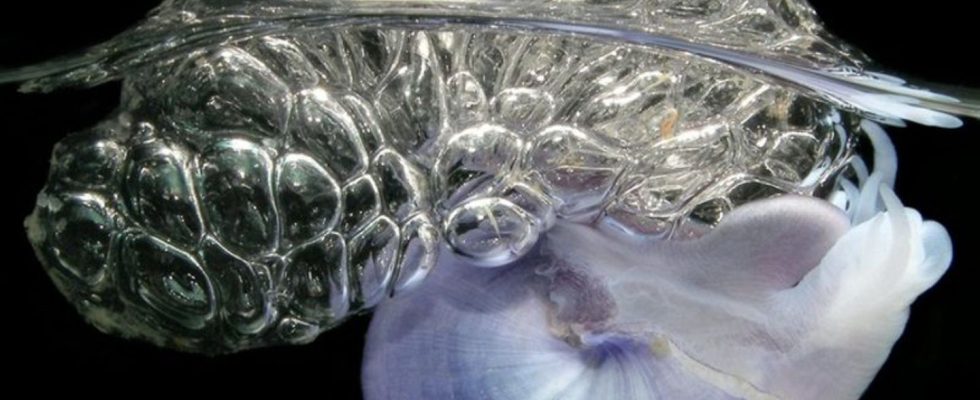Environment
“Blue Fleet” in the garbage: a special ecosystem on the high seas
A specimen of the snail Janthina builds a raft out of bubbles. photo
© Denis Riek/The Global Ocean Surface Ecosystem Alliance/dpa
Tens of thousands of tons of plastic are floating in the sea in huge garbage eddies. But special creatures also appear there in large numbers. That could have consequences.
In addition to tens of thousands of tons of plastic, the Great Pacific Garbage Patch is also home to an abundance of marine life just below the surface. As a research team reports in the journal “PLOS Biology”, the number is particularly high in areas with a particularly large amount of plastic waste. The scientists therefore fear that attempts to fish the garbage out of the oceans of all things could pose a threat to these ecosystems.
The so-called Neuston, after the Greek “the floating one”, is a special maritime community. It describes all of the animals, plants and microorganisms that live mainly directly under the water surface. Many of these creatures have a distinctive blue or purple coloration that is thought to protect against UV rays or act as camouflage from predators. Accordingly, the animals are also called “blue fleet”. Neuston genera are found worldwide, but only one marine region is currently known to have high densities, the Sargasso Sea east of Florida.
Since the Neuston organisms use currents to move in the open ocean, a team led by biologist Rebecca Helm suspected that they can also be found en masse in the great garbage patches of the world’s oceans. Such plastic vortices form when surface currents drive plastic pollution off shores into regions where rotating currents trap the floating objects. There are at least five such vertebrae contaminated with plastic worldwide. The most extensive is the Great Pacific Garbage Patch between Hawaii and California. According to a study published in 2018, almost 80,000 tons of plastic are floating here.
In 2019, Helm’s scientists, who conduct research at Georgetown University in the United States, accompanied the French record-breaking long-distance swimmer Ben Lecomte, who swam through the Pacific garbage patch in 80 days as part of the “The Vortex Swim” campaign to look at marine pollution to draw attention to.
During the tour, Helm’s team collected samples daily and found more neustonic marine life within the North Pacific Gyre than on its margins. The occurrence of plastic waste correlated particularly with the frequency of three genera: sail jellyfish (Velella), which look like a round blue raft with a transparent sail, purple violet snails (Janthina) and blue button jellyfish (Porpita), which are actually not jellyfish but rather belonging to the hydrozoan family.
The researchers themselves write that their study can only provide random results. Nonetheless, their work suggests that the same ocean currents that concentrate plastic debris in ocean eddies may be critical to the life cycles of aquatic marine organisms, using them for feeding and mating brought together. In fact, the marine biologists detected offspring of sailing jellyfish in at least one sample.
However, human activities could adversely affect these high seas meeting places and the wildlife that depend on them. According to the study, the Neuston organisms served as an important food source for seabirds, fish and turtles.
For Rebecca Helm, human activities include projects such as “The Ocean Cleanup”, in which waste is collected from the sea with huge catchers. In the past, Helm had been critical of it several times: in 2019, for example, at a symposium at the University of Liverpool on the project, she said that it could pose a danger to the “blue fleet” – a warning that “The Ocean Cleanup” says wrong assumptions.
Most importantly, there is no evidence that plastic waste and Neuston are co-located, said project founder Boyan Slat in a comment published online. Her study now provides new information for Helm and her team. Although more and better data are needed to draw conclusions about the exact neuston distribution in the North Pacific Gyre and other ocean gyres, it is already obvious that these are not just collection points for plastic waste: “They are ecosystems, not because of, but despite of the plastic.”

